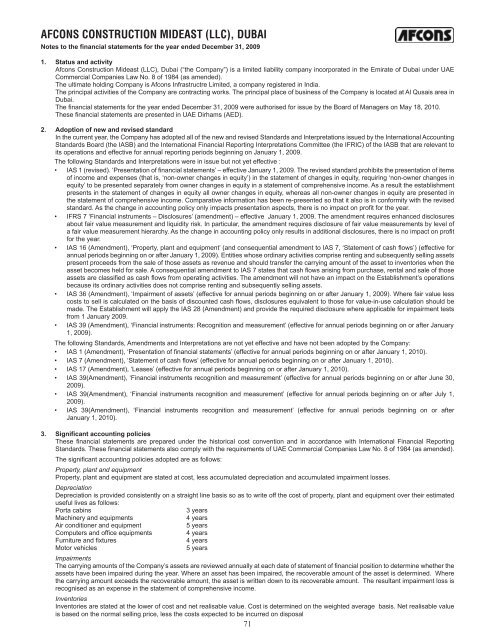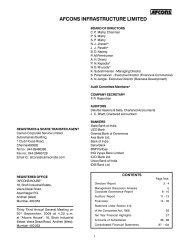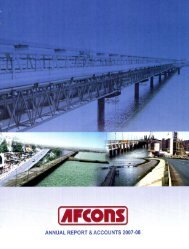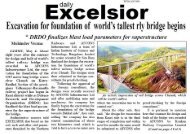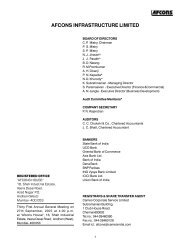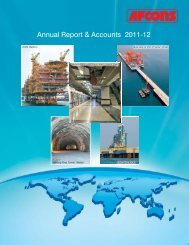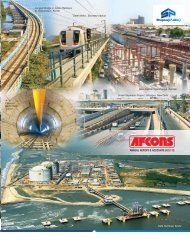Afcon Book.indd - Afcons Infrastructure Ltd.
Afcon Book.indd - Afcons Infrastructure Ltd.
Afcon Book.indd - Afcons Infrastructure Ltd.
You also want an ePaper? Increase the reach of your titles
YUMPU automatically turns print PDFs into web optimized ePapers that Google loves.
AFCONS CONSTRUCTION MIDEAST (LLC), DUBAINotes to the financial statements for the year ended December 31, 20091. Status and activity<strong>Afcon</strong>s Construction Mideast (LLC), Dubai (“the Company”) is a limited liability company incorporated in the Emirate of Dubai under UAECommercial Companies Law No. 8 of 1984 (as amended).The ultimate holding Company is <strong>Afcon</strong>s Infrastructre Limited, a company registered in India.The principal activities of the Company are contracting works. The principal place of business of the Company is located at Al Qusais area inDubai.The financial statements for the year ended December 31, 2009 were authorised for issue by the Board of Managers on May 18, 2010.These financial statements are presented in UAE Dirhams (AED).2. Adoption of new and revised standardIn the current year, the Company has adopted all of the new and revised Standards and Interpretations issued by the International AccountingStandards Board (the IASB) and the International Financial Reporting Interpretations Committee (the IFRIC) of the IASB that are relevant toits operations and effective for annual reporting periods beginning on January 1, 2009.The following Standards and Interpretations were in issue but not yet effective :• IAS 1 (revised). ‘Presentation of financial statements’ – effective January 1, 2009. The revised standard prohibits the presentation of itemsof income and expenses (that is, ‘non‐owner changes in equity’) in the statement of changes in equity, requiring ‘non‐owner changes inequity’ to be presented separately from owner changes in equity in a statement of comprehensive income. As a result the establishmentpresents in the statement of changes in equity all owner changes in equity, whereas all non‐owner changes in equity are presented inthe statement of comprehensive income. Comparative information has been re‐presented so that it also is in conformity with the revisedstandard. As the change in accounting policy only impacts presentation aspects, there is no impact on profit for the year.• IFRS 7 ‘Financial instruments – Disclosures’ (amendment) – effective January 1, 2009. The amendment requires enhanced disclosuresabout fair value measurement and liquidity risk. In particular, the amendment requires disclosure of fair value measurements by level ofa fair value measurement hierarchy. As the change in accounting policy only results in additional disclosures, there is no impact on profitfor the year.• IAS 16 (Amendment), ‘Property, plant and equipment’ (and consequential amendment to IAS 7, ‘Statement of cash flows’) (effective forannual periods beginning on or after January 1, 2009). Entities whose ordinary activities comprise renting and subsequently selling assetspresent proceeds from the sale of those assets as revenue and should transfer the carrying amount of the asset to inventories when theasset becomes held for sale. A consequential amendment to IAS 7 states that cash flows arising from purchase, rental and sale of thoseassets are classified as cash flows from operating activities. The amendment will not have an impact on the Establishment’s operationsbecause its ordinary activities does not comprise renting and subsequently selling assets.• IAS 36 (Amendment), ‘Impairment of assets’ (effective for annual periods beginning on or after January 1, 2009). Where fair value lesscosts to sell is calculated on the basis of discounted cash flows, disclosures equivalent to those for value‐in‐use calculation should bemade. The Establishment will apply the IAS 28 (Amendment) and provide the required disclosure where applicable for impairment testsfrom 1 January 2009.• IAS 39 (Amendment), ‘Financial instruments: Recognition and measurement’ (effective for annual periods beginning on or after January1, 2009).The following Standards, Amendments and Interpretations are not yet effective and have not been adopted by the Company:• IAS 1 (Amendment), ‘Presentation of financial statements’ (effective for annual periods beginning on or after January 1, 2010).• IAS 7 (Amendment), ‘Statement of cash flows’ (effective for annual periods beginning on or after January 1, 2010).• IAS 17 (Amendment), ‘Leases’ (effective for annual periods beginning on or after January 1, 2010).• IAS 39(Amendment), ‘Financial instruments recognition and measurement’ (effective for annual periods beginning on or after June 30,2009).• IAS 39(Amendment), ‘Financial instruments recognition and measurement’ (effective for annual periods beginning on or after July 1,2009).• IAS 39(Amendment), ‘Financial instruments recognition and measurement’ (effective for annual periods beginning on or afterJanuary 1, 2010).3. Significant accounting policiesThese financial statements are prepared under the historical cost convention and in accordance with International Financial ReportingStandards. These financial statements also comply with the requirements of UAE Commercial Companies Law No. 8 of 1984 (as amended).The significant accounting policies adopted are as follows:Property, plant and equipmentProperty, plant and equipment are stated at cost, less accumulated depreciation and accumulated impairment losses.DepreciationDepreciation is provided consistently on a straight line basis so as to write off the cost of property, plant and equipment over their estimateduseful lives as follows:Porta cabins3 yearsMachinery and equipments4 yearsAir conditioner and equipment5 yearsComputers and office equipments4 yearsFurniture and fixtures4 yearsMotor vehicles5 yearsImpairmentsThe carrying amounts of the Company’s assets are reviewed annually at each date of statement of financial position to determine whether theassets have been impaired during the year. Where an asset has been impaired, the recoverable amount of the asset is determined. Wherethe carrying amount exceeds the recoverable amount, the asset is written down to its recoverable amount. The resultant impairment loss isrecognised as an expense in the statement of comprehensive income.InventoriesInventories are stated at the lower of cost and net realisable value. Cost is determined on the weighted average basis. Net realisable valueis based on the normal selling price, less the costs expected to be incurred on disposal71


